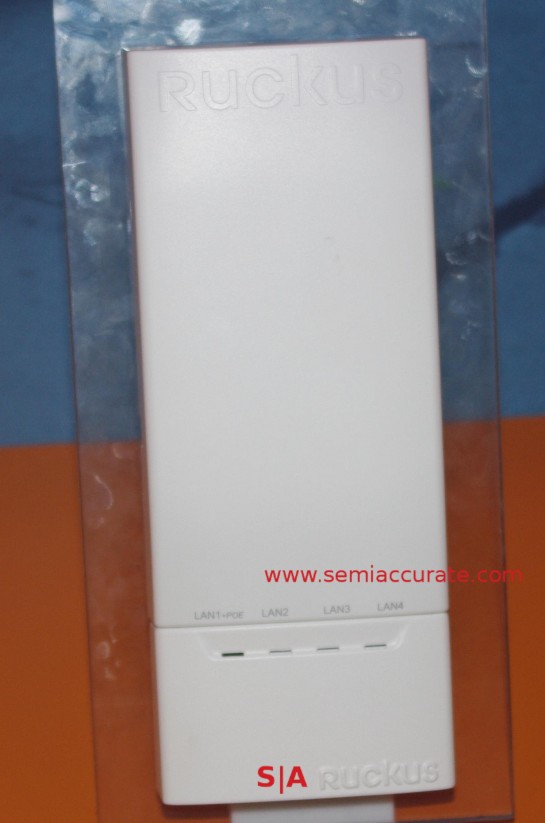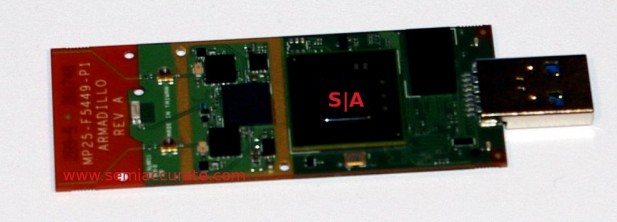 Ruckus was showing off working 3.5GHz LTE silicon at MWC, and it will have major impacts. The devices SemiAccurate saw are based on a Qualcomm modem in an interesting form factor too.
Ruckus was showing off working 3.5GHz LTE silicon at MWC, and it will have major impacts. The devices SemiAccurate saw are based on a Qualcomm modem in an interesting form factor too.
The idea is simple, there is a new LTE band available at 3.5GHz and it is primarily for small cells rather than macrocells. Most implementations are going to be smaller, rooms or floors in buildings so they will be both low power and short-range, both a good thing. One of the interesting net results of this open and short-range spectrum availability is that 3.5GHz is effectively carrier agnostic, a massive win for users. As long as the infrastructure can be deployed in a timely manner things will be much better, and that is where Ruckus comes in.

Ruckus H510 with Q210 module installed
The box you see above is the Ruckus ZoneFlex H510 dual-band 802.11ac Wall Mount Access Point with the Q210 LTE AP Add-on PoC module at the bottom. H510 is a pretty standard access point, if you have been in a hotel in the last few years, you probably have used one of these devices or something very similar. They are deployed with a H510 for every two rooms or so, but not much less dense than that for coverage without massive RF mapping headaches. Central control and management allows this all to work sanely and cost effectively.

3.5GHz LTE picocell on a USB stick
New to the APs is the Q210 and as the name suggests it is an LTE access point based on the Qualcomm FSM9016 USB board. As you can see above it is effectively a memory stick sized USB LTE picocell. That is an impressive feat but kind of pointless if you needed to deploy one for every carrier out there, or at least several to cover all the necessary bands to have sane LTE coverage. Worse yet you would need to get carrier approval and coöperation for anything to work right, want to guess the odds on that happening?
This is where 3.5GHz comes in because it is carrier agnostic. With the Q210/FSM9016 USB, Ruckus can offer a ‘universal’ LTE cell for offices and hotels. Since it is just a module for the H510 and USB based, installing the module isn’t a job for an engineer, almost anyone with a clue can plug it in. Configuring the whole deal is not quite so simple but the physical deployment is comparatively easy compared to most infrastructure jobs. And since it is so important let me harp on it again, 3.5GHz means carrier agnostic open spectrum so it is ‘universal’ and you only really need to deploy one for all users.
Things get more interesting when you look at the possibilities. The FSM9016 in conjunction with the H510 and presumably some clever firmware can sort packets on the fly based on LTE packet tags. As long as a carrier is playing nice, and since it is in their benefit to do so they are actually likely to coöperate, this H510/Q210 combo can simply pull internet data out of the LTE stream and dump it directly to the net gateway. Cellular voice, text, and related traffic can be sent to the appropriate carrier, again over the internet but to a defined endpoint where it is dealt with by the normal cellular infrastructure like any other small cell traffic.
This saves massive bandwidth on scarce LTE spectrum, allows much faster data rates if the backhaul is there, and is effectively universal. The small range of the cells mean there are only going to be a handful of devices per cell so congestion should be minimal and the format Ruckus used makes deployment relatively painless.
From the user perspective, they just go into an office or hotel and their phone will just work, no sign up, no passwords, just standard LTE. What happens to those packets is a bit more complex but pretty straightforward in the grand scheme of things. 3.5Ghz should allow much more complete coverage in problematic buildings, underground locations, and all the other places you curse at your carrier. The only real delay is going to be getting 3.5GHz capable phones out there but the Qualcomm X16 modems have that capability, as will almost every new modem in short order. This will make everything better, and do it in the right way.S|A
Charlie Demerjian
Latest posts by Charlie Demerjian (see all)
- Qualcomm Is Cheating On Their Snapdragon X Elite/Pro Benchmarks - Apr 24, 2024
- What is Qualcomm’s Purwa/X Pro SoC? - Apr 19, 2024
- Intel Announces their NXE: 5000 High NA EUV Tool - Apr 18, 2024
- AMD outs MI300 plans… sort of - Apr 11, 2024
- Qualcomm is planning a lot of Nuvia/X-Elite announcements - Mar 25, 2024